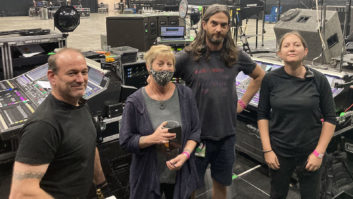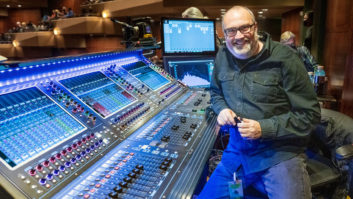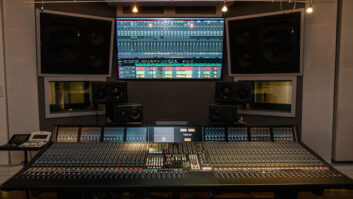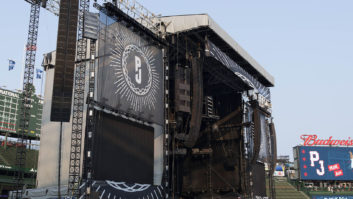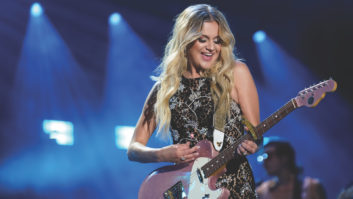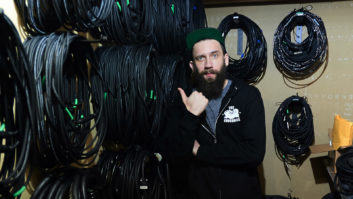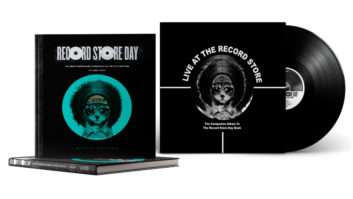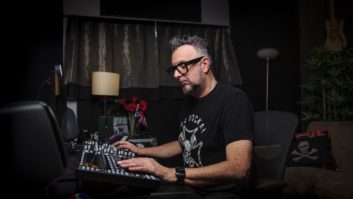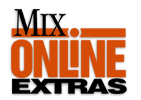
Pearl Jam, one of the most important bands of the 1990s, is still avital force in American rock. Anchored by the passionate singing oflead vocalist Eddie Vedder and the guitars of Stone Gossard and MikeMcCready, Pearl Jam — along with Nirvana — propelled grungerock into the mainstream and fostered a host of less-impressiveimitators. The band also pioneered the release of “officialboot-legs,” a concept that has been taken up by groups such asPhish and String Cheese Incident. Each show can be ordered at www.pearljambootlegs.com; MP3s of each song fromthe show are available for download the day after the concert to tidefans over until the CD arrives. The group is currently on the road witha huge production in support of their latest album, RiotAct.

The band’s sound engineer, Brett Eliason, has been with Pearl Jamsince their first tour. To meet the demands of releasing the shows onCD, Eliason is mixing the show from a truck in the back of the venue,sending a feed to another console at FOH. He is using a Midas XL4console on this tour. “I chose the XL4 because of its routingcapabilities. I have signal going to a lot of places. I wish it had alittle more in the way of inputs and outputs — especially outputs— though most people in a live situation don’t run into thatlimitation. I have 56 inputs going, and for outputs, I send 22 lines toFOH, two outputs to stereo recordings and a 48-channel multitrack, allsimultaneously.”
From the XL4, he sends one stereo feed to a Panasonic SV3700 DAT;one stereo feed to an Apogee PSX-100 A/D that sends a digital feed toan Apple Powerbook G4 running Pro Tools LE recording in 24/48; onestereo feed to a MOTU 828 FireWire recording setup that sends a feed toanother Powerbook G4 running Peak Audio to do the MP3 mixes; andanother feed to a 48-track Pro Tools hard drive system. Eliasonexplains, “When you go online to buy a show, you are given a linkto go download MP3s of each song. We knew they would be traded, so weput them at low resolution so people would still want the CDs. The MP3sare uploaded to a Sony server. The 24-bit stereo files for the bootlegsare being uploaded by Wam!Net. We have sites from all of the cities wewill play that let us upload the files to a mastering lab in Seattle.When the mastering engineers come in the next morning, the files arewaiting for them. They then use the Wam!Net servers to send themastered files to a Sony pressing plant, so by the second day, the discimages are available for pressing CDs. We are done within 48 hours, andthe discs are shipped. I also have an HHB830 Plus CD burner in there sothat the band can have whatever they want when they want it. We recordeverything they play, including soundcheck.”

Meanwhile, Eliason is sending submixes to a Midas Heritage 3000console at FOH that is run by Mike Scerra, who fine-tunes the mix forthe P.A. Says Scerra, “Brett sends me 22 submixes, 20 of which Iuse. The last two I use to monitor the mix through headphones. The K-TDN3600 is inserted on the left and right and used to control anyblatant frequency problems. The Aphex Dominator is used to catch thepeaks and contour the high and low end so things don’t get too out ofhand. The BSS units are standard omnidrive digital DSP crossovers. Werun four of them and also use them for other finite EQ. We EQ withthose first because you can get much tighter control of the frequenciesinstead of using the DN3600 to grab a whole octave. I’m doing a mildremix to make sure that the vocals are up and monitor the P.A. to makesure it sounds consistent throughout the show. We use almost no EQ onthe console.”
Pearl Jam is carrying an EAW line array provided by Carlson on thecurrent tour; Carlson’s Alan Bagley is working as the system tech.“We used the EAW in Seattle for some one-offs we did lastyear,” Eliason says. “The Key Arena, where the SuperSonicsplay, is boomy and swirly, and the EAW worked great there; it was easyto control. I was very impressed that in the 300-level seats, you hadclarity and power. I had friends sitting up there during the show, andthey said they had never gotten that clarity that high up. At FOH, Ithink we run 102 to 104 dB A-weighted, at a typical 110 feet from thestage.”
Bagley has worked for Carlson for seven years, doing specialprojects like festivals. He explains the system setup this way:“We use two computer programs. One is the 760 Wizard, which tellsus how to aim and hang the thing. To gather data for that, we spendtime with some surveyor tools to figure distance and angles. After thesystem is up, we use Smaart Live to look for minor problems. Mike useshis voice and a couple CDs to fine-tune it further. They don’t spend alot of time at it. Here at Pepsi Center, we are using 24 KF760s and 24761s — 12 on a side — 24 SB1000s subs — stacked threehigh and four wide on each side of the stage — nine KF750s andKF755s for rear coverage, and six JF2000s underneath the front of thestage for the nearfills. I’d prefer to put them on the front edge ofthe stage, but because of the front-line monitors being so close to theedge of the stage, we can’t put them there. The Pepsi Center is areally tall room; the bottom of the P.A. is about 39 feet off of theground, which is the highest I’ve ever run a P.A. That seems the bestway to run line arrays, though, to assure better coverage front toback. Other than demo’ing other people’s line arrays, this is arelatively new field for us. We’ve been an EAW company for a long timeand like the way the boxes perform. We like the consistency of soundfrom each box. We thought about some other line arrays, but it wouldhave been a real departure for us. Also, when we purchased this P.A.,we did it specifically for this tour because the demo we did at the KeyArena went fabulously well, and Brett and Mike loved the system. All ofthe amps are QSC Powerlight 6.0s and 4.0s. We have the 4.0s for thehighs and 6.0s for mids, lows and subs. We use two BL236s for thenearfills, 12 6.0s per side and three 4.0s for the front. We haveadditional QSCs on the rear P.A.s, three each of 4.0s, 3.4s, and 3.8sfor the 750s and 755s.”

Monitors are handled by Karrie Keyes, who has been working withPearl Jam for 12 years: “I started by doing shows in clubs andtheaters in L.A., which is where I am based,” she says. “Iwas doing monitors for the Red Hot Chili Peppers, and Pearl Jam was theopening band, so at the end of the tour, I hooked up with them. Foryears, I did both bands and leapfrogged back and forth. Since Pearl Jamand the Peppers overlap with each other, I sometimes cover for thePeppers’ monitor guy, but I am pretty much full time with Pearl Jamnow.”
Keyes mixes on a Yamaha PM 4000M, which she says is not her firstchoice, but the choice of the band. “We’ve done so many tours,especially in the early years when we would tour almost constantly, andthat is the board they got used to. Every time I use a differentconsole, the sound is never quite right.”
The monitor system is provided by Rat Sound Systems Inc. and hasbeen designed especially over the years to meet the exacting needs ofthe band. Keyes details each player’s mix as follows: “Themonitor system is almost completely a Triamp system, predominantlyusing Klark Teknik DN800 crossovers and TAD 2-inch drivers withwaveguide horns. These were designed for the band in order to makevocals as loud and clear as possible onstage. Stone has an L-Wedge forall instrumentation and guitars. He also has an S-Wedge for his vocal,a Trap 5 sidefill triamp cabinet with full instrumentation in it, and aRat Sub cabinet for kick and bass. Ed has two S-Wedges for vocals andan L-Wedge for instruments. He gets guitar, his acoustics and ukulele,and a lot of cues throughout the show from Mike and Stone, but theyaren’t in there all the time. He also has four S-Wedges for rearfillswith vocal, and two vocal monofills in Rat Trap 5 triamp cabinets onthe stage. Jeff has an M-Wedge with a McCauley 15-inch driver in it. Itis a triamp wedge, but I only use the McCauley in it, and he just getslow end from the kick drum. He also has a Rat-designed bass wedge infront of him, but it’s controlled by his Ampeg heads. Mike has anL-Wedge and gets a little of Stone in it and that’s it. That side ofthe stage has a lot of hearing issues, so I keep it quiet over there.Any high end just kills Jeff and Mike; they both share a Rat Sub thathas low end from the kick. Matt has two Rat Trap 4 drumfill cabinetsand a Rat Sub. He has just about everything in there; I don’t thinkthere is one instrument on stage that he doesn’t have. Boom has anM-Wedge and gets kick and snare, his keys, all of Stone’s guitars andEd’s vocal.”
While music is, obviously, the band’s primary focus, the members ofPearl Jam have also gained notoriety speaking out on issues thatconcern them. During the 2000 presidential election, they encouragedlisteners to vote for Ralph Nader. They have also been vocal in their(unsuccessful) challenge of Ticketmaster. And controversy continues tofollow them: The song “Bu$hleaguer,” a scathing indictmentof President Bush, and the group’s stance against the war in Iraq havedrawn criticism in some circles. They’re sure to keep stirring thingsup, politically and musically, as the Riot tour continues into thesummer months.
Candace Horgan is a freelance writer based in the Denverarea.

Want to learn more about Pearl Jam’s mic set-up onstage? Clickhere for the scoop.
Portraits of Pearl Jam onstage, by photographer MichaelWeintrob / www.groovetography.com




